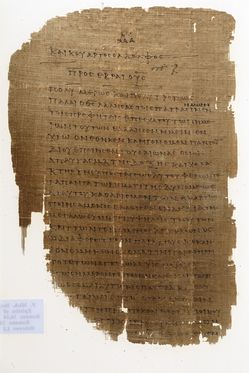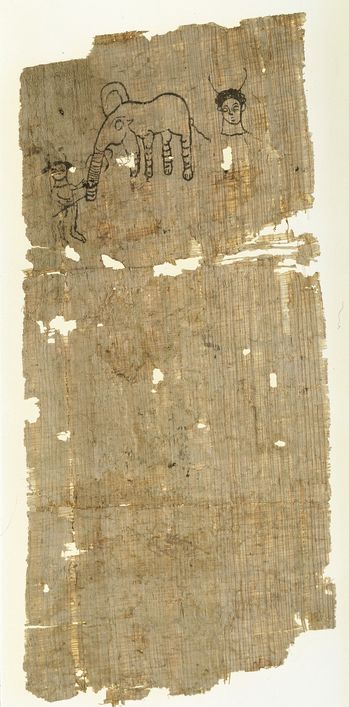U-M's Hatcher Library showcasing ancient papyrus

"Epistles of St. Paul" (late second/early third century)
“From Trace to Text: Highlights from the University of Michigan Papyrus Collection” in the U-M Harlan Hatcher Graduate Library Audubon Room is one of those rare events where the title meticulously describes its intent: “From Trace to Text” constitutes half of the exhibit, and “Highlights from the U-M Papyrus Collection” covers the other half.
“From Trace to Text” is fascinating for the glimpse it provides us of the art and science of papyrology —as a gallery card tells us, “the field of scholarship that deciphers and studies ancient texts written on papyrus, the primary writing material of antiquity.”
Examples of this effort include a display case showing us what the ancient parchment looks like when it’s collected, before it’s examined and evaluated. A shoebox-sized container on hand filled with scraps of this aged paper-like material is anything but impressive. From an initial look, it would seem making any sense of this crumply stuff would require a superhuman effort.
All the more impressive, therefore, that the display shows us rolls of these papers and the task it takes to unravel, then decipher them. From conservation efforts (cleaning and straightening) to the technology it takes to “read” them (including infrared photography and X-ray CT scanning), the papyrologist must take the most delicate care to not destroy these fragile ancient scraps.
And the reading requires a probable facility in any number of languages (in various scripts) such as Egyptian, Aramaic, Ancient Greek, Latin, and Arabic. Assuming, of course, the fragment has enough information to make some semblance of meaning.
It’s therefore understandable that papyrologists have the academic standing they hold. Each step is fraught with the danger of losing the vaguely written record while trying to decipher it for posterity. Such a task takes a gambler’s nerve coupled with the dedication of infinitely patient scholarship.
This exhibit richly represents the U-M’s famed papyrology collection. It's dedicated to the late Traianos Gagos, a U-M professor of papyrology and Greek. He was instrumental in fostering the team that created the Advanced Papyrological Information System online database, which combines descriptions and images of papyrus fragments from around the world.

"Sketch of an Elephant with Two Figures" (fifth/sixth century)
These papyrology works, in the second half of the display, include two of only a dozen surviving pages from the earliest known manuscript of the Epistles of St. Paul (late second/early third century). As the gallery’s tag tells us, the “unusual characteristic” of one of the pages “is the placement of Hebrews (1:7) directly after Romans (16:23) in an order different from modern editions of the New Testament.”
Other notable fragments include two wax tablets declaring the “Birth Certificate of Herennia Gemella” from Alexandria, Egypt dated August 12, 128 (written in Latin with one line in Greek); being a status symbol of that time because of its proof of Roman citizenship. Another exciting find is Euclid’s “Elements 1, Definitions 1-10” written in Greek in the 3rd century. And four small strips of papyrus on a bracelet represent a mysterious side to the collection, since the currently undeciphered strips were rolled around on a string and possibly worn as a charm around the bearer’s arm.
Granted each document on display is remarkable. But if a single work is bound to catch the viewer’s attention, it’s likely a fifth/sixth century “Sketch of an Elephant with Two Figures” papyrus whose meaning is still uncertain. It’s been determined that the drawing is on the back of an invitation “ although it is unclear if the sketch is related to the content of the letter or simply a doodle created during a moment of leisure.”
Whether doodle or direction; this fascinating little scrap of paper now occupies an honored place in the sphere of academia. It would have been inconceivable to the original owner that his off-the-cuff sketches would one day be privileged in this way. But, as Gagos was obviously keenly aware a millennium and a half later, such is the vicissitude of papyrus — as an art and a science.
“From Trace to Text: Highlights from the University of Michigan Papyrus Collection” will continue through December 22 at the University of Michigan Harlan Hatcher Graduate Library Audubon Room, 920 N. University St. Exhibit hours are 8:30 a.m.-7 p.m. Monday-Friday; 10 a.m.-6 p.m. Saturday; and 1-7 p.m. Sunday. For information, call 734-764-0400.

